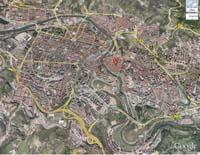Cities, harmful to mental health
The research has been carried out at the University of Heilderberg (Germany). Previously, these methods were used to investigate the relationship between certain genes and the risk of mental illness. However, with their current study, they have seen that the measure of the place of residence influences more than genes in mental illnesses such as schizophrenia.

The inhabitants of the cities have a higher risk of suffering mental illnesses than the villages. In the image, Bilbao. (Photo: Google lemaps)
One in a hundred inhabitants has schizophrenia and has a great influence on society. Scientists have identified about a dozen genes associated with schizophrenia, but none of them have a very high relationship: the most related gene only increases the risk of schizophrenia by 20%. On the contrary, schizophrenia is twice more frequent among the population than in rural nuclei. And the bigger the city is, the more usual it is.
In view of this, Heilderberg researchers analyze the influence of the measurement of the place of residence in the brain. Thus, through magnetic resonance, 32 volunteer German students have analyzed their brains. Volunteering lived in three measures of “cities of more than one hundred thousand inhabitants, villages of more than ten thousand inhabitants and rural nuclei”, and in the experiment they wanted to see how they reacted to a situation of stress.
See results of the experiment
To do this, they made them perform a series of mathematical exercises, at the same time they made them listen to pessimistic messages to provoke stress. For example, they were told that they were worse than average and that they were trying to do better, that the experiment was very expensive. Measuring the physiological parameters of the students (heart rate, blood pressure and stress hormone concentration), they stated that the messages were really effective in the production of stress.
Subsequently, the images obtained through magnetic resonance were analyzed and the difference between the population and the rural population was noticed. In this situation a non-active zone is activated in the rural ones in the brains of the citizens: the amygdala. The amygdala, among other things, measures social risk and is disproportionately activated in people with anxiety problems.
In addition, the activation of another space is much more evident in citizens than in rural ones. It is an area called pantanous crust, which helps to regulate the amygdala and processes pessimistic emotions. This space connects with schizophrenia, among other things.
To confirm the results, the experiment was performed again with other volunteers and the incorporation of optical signals (the volunteers had the possibility of seeing the researchers in front). In the activity of the brain, once again, there was a clear difference between the citizens and the rural ones.
Therefore, the researchers conclude that the measure of the place of residence conditions the response to stress. Thus, living in cities increases the risk of mental illness, since the response to social stress in the brain is less adequate than if we live in rural areas.
The study has served to demonstrate what epidemiologists said, but researchers expect it to be useful for the future, as they hope it will contribute to designing healthier cities.
Published in Annex GAUR8.
Buletina
Bidali zure helbide elektronikoa eta jaso asteroko buletina zure sarrera-ontzian











